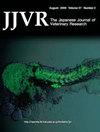硫丹农药对蟾蜍的影响。
IF 0.3
4区 农林科学
Q4 VETERINARY SCIENCES
Japanese Journal of Veterinary Research
Pub Date : 2013-02-01
引用次数: 0
摘要
研究了硫丹对非洲蟾蜍(Bufo regularis)的致死和亚致死毒性,以评估其行为和能量储备的变化。96 h LC50为0.730 mg/l,而安全浓度估计为0.07 mg/l,表明该杀虫剂具有较高的毒性。暴露于致命浓度硫丹的蟾蜍表现出剂量依赖性行为异常,浓度越高,中毒症状越明显。农药引起血清葡萄糖水平的差异升高,同时伴有肝糖原的降低,表明由于农药诱导的应激导致碳水化合物代谢紊乱,因此可以作为农药毒性研究的合适生物标志物。本文章由计算机程序翻译,如有差异,请以英文原文为准。
Effects of endosulfan pesticide on toad.
The lethal and sublethal toxicity of Endosulfan on the African toad, Bufo regularis were evaluated to assess changes in behaviour and energy reserves. 96 hours LC50 was 0.730 mg/l while the estimated safe concentration was 0.07 mg/L indicating the high toxicity of the insecticide. Toads exposed to lethal concentrations of endosulfan showed dose-dependent behavioural abnormalities with more pronounced poisoning symptoms occurring at higher concentrations. The pesticide caused differential increase in serum glucose levels with a concomitant reduction in liver glycogen indicating disorders in carbohydrate metabolism due to pesticide induced stress and hence can serve as suitable biomarkers in pesticide toxicity studies.
求助全文
通过发布文献求助,成功后即可免费获取论文全文。
去求助
来源期刊
CiteScore
1.00
自引率
0.00%
发文量
0
审稿时长
>36 weeks
期刊介绍:
The Japanese Journal of Veterinary Research (JJVR) quarterly publishes peer-reviewed articles on all aspects of veterinary science. JJVR was originally published as a “University Journal” of veterinary science at Hokkaido University from more than 60 years ago. Currently, JJVR, is Japan’s leading scientific veterinary journal, and provides valuable information for the development of veterinary science by welcoming contributions from researchers worldwide.
JJVR offers online submission for Regular Papers, Short Communications, and Review Articles that are unpublished and not being considered for publication elsewhere. Research areas include:
Anatomy, Physiology, Biochemistry, Pharmacology, Microbiology, Infectious diseases, Parasitology, Laboratory Animal Science and Medicine, Internal Medicine, Surgery, Pathology, Theriogenology, Molecular Medicine, Public Health, Radiation Biology, Toxicology, Wildlife Biology and Medicine, Veterinary Hygiene, The other fields related to veterinary science.

 求助内容:
求助内容: 应助结果提醒方式:
应助结果提醒方式:


